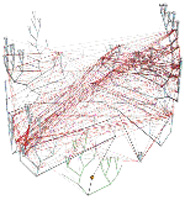From trees of life to scale-free networks: a new vision for bacterial evolution
A new pattern for microbial genetic relationships has been revealed by researchers from the European Bioinformatics Institute (EBI), changing the conventional views of four billion years of bacterial evolution. The EBI team, headed by Christos Ouzounis, has found clues to how gene families are transferred, not only 'vertically' through passage from one organism to its progeny, but also 'horizontally' through the exchange of genetic material between distantly related organisms. This new view of the tree of life could help researchers to better understand why bacterial diseases are so hard to fight - the bacteria keep on managing to produce antibiotic resistant strains, continuously outpacing the development of drugs. Since the time of Darwin, the evolutionary relationships between organismsare conventionally represented as a tree, in which the common ancestors areto be located at the base of the trunk and the most recently evolved speciesat the tips of the branches. Microbiologists have been arguing for a long time that this representation does not fit for microbes, as these often exchange genes among different species. According to experts, the proposed model of microbial evolution would be better represented by a net. The problem was that, up until now, no-one knew exactly where to draw the horizontal lines in this net. Victor Kunin, a former PhD student in Dr Ouzounis's team, has, with colleagues, now succeeded in constructing a map of microbial evolution, going back billions of years to the last universal common ancestor. This includes, for the first time, these horizontal lines. 'Reassuringly, evolutionary trees constructed by many independent methods and different research groups are remarkably consistent with each other, projecting the same story. We used these trees as the scaffold of the net, on which we looked for the evidence of horizontally transferred genes,' explains the researcher. The method employed to assess how horizontal gene transfer occurs, called 'GeneTrace', was previously developed by Dr Ouzounis's team. GeneTrace infers this horizontal transfer from the patchy presence of a gene family in distantly related organisms. The data generated by GeneTrace allowed them to draw 'vines', representing horizontal-gene-transfer events, connecting branches on the evolutionary tree. In all, more than 600,000 vertical transfers are observed, coupled with 90,000 gene loss events and approximately 40,000 horizontal gene transfers. And although the distribution of most of the gene families present today can be explained with the classical theory of evolution by descent, anomalies of these patterns can be revealed by the 'minority report' of horizontal exchange. To understand the influence of horizontal gene transfer on the microbial tree of life, the team focused on the network of vines coursing through the tree's branches. This network appears to behave in a 'scale-free' manner. This term was first coined by physicist Albert-Laszlo Barabasi and his colleagues at the University of Notre Dame, Indiana, in the US. In 1998, they mapped the connectedness of the World Wide Web and found, to their surprise, that the web did not have an even distribution of connectivity (so-called 'random connectivity') but instead, a very few network nodes (called 'hubs') were far more connected than other nodes. One property of scale-free networks is their 'small-world' nature: travelling from one node to any other is very fast. Other well-known examples of small-world networks include social networks and air-travel connections. These characteristics allow the hubs to serve as bacterial 'gene banks', providing a medium to acquire and redistribute genes in microbial communities. According to Christos Ouzounis, this pattern has important implications for the understanding of horizontal gene transfer because, in small-world networks, the shortest path between any two network nodes is relatively small. In other words, 'a gene can rapidly be disseminated from organism to organism through very few horizontal gene transfer events', explains the scientist. A few species, including beneficial nitrogen-fixing soil bacteria, appear to be 'champions' of horizontal gene transfer. 'It's entirely possible that apparently harmless organisms are quietly spreading antibiotic resistance under our feet,' concludes Christos Ouzounis.
Countries
Germany



